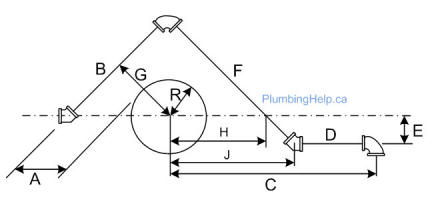A jumper offset in a plumbing system uses a combination of fittings to go around an obstacle, such as a cylindrical tank. If your planning on writing a plumbing exam, rest assured that a jumper offset will be on the exam.
Using simple math and various constants, it’s possible to find the required center-to-center lengths for each pipe in the offset, which are outlined below.
To find the missing values in a jumper offset you will need to remember the constants for right angle triangles used in a 45 degree offset; which are:
- To find the hypotenuse (the long side) multiple a short
side by 1.414 - To find a short side when the hypotenuse is known, multiply it by 0.707
Jumper offset using 45-90-45 fittings

Use the image above to sketch out the jumper offset using the variables on the right. After a couple practice runs, try changing the numbers.
R – 4″
A = 3″
E = 2″
C – 20″
Step 1 – The first thing you need to find is the side of the secondary square (G). So add (R) + (A) = (G)
4 + 3 = 7″ This number is known as the secondary square (G).
Step 2 – Multiplying the secondary square by 2 will give you the length of pipe (B), and the length of pipe (F) to the centerline of the tank.
(G) x 2 = (B) so to find the end to end length of pipe (B) which ends on the center line it would be 7″ x 2 = 14″.
Step 3 – To find the length of pipe (F) will require two steps, first you have to multiply dimension (E) by 1.414 to find the length of pipe (F) below the centerline of the tank, then add that number to result you got in step two above.
2″ x 1.414 = 2.828 then 2.828″ + 14″ = 16.828″ or roughly 16 7/8″
Step 4 – To find (H) also known as the offset, multiply the diagonal (B) by the constant 0.707
(H) = 14 x 0.707 = 9.898″
Step 5 – Find dimension (J) by adding the offset (H) with (E)
(H) +(E) = (J) / 9.898 + 2 = 11.898″
Step 6 – Finding the length of pipe (D) is simple subtraction.
(C) – (j) = (D)
20 – 11.898 = 8.102″
